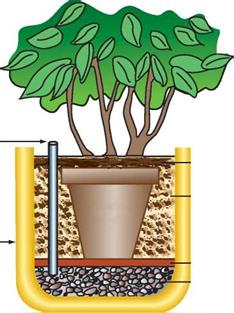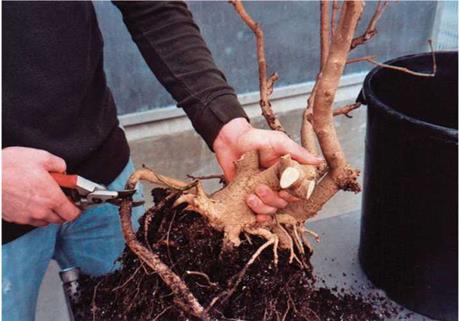The acclimatization of a plant’s root system involves establishment of the correct relationship between roots and foliage. Outdoors, a sizeable root system is needed to supply adequate amounts of water and minerals to the leaves for near-maximal photosynthesis. Indoors, photosynthesis is reduced to survival-maintenance levels, so the root system need not be as large. Therefore, one of the first steps at the time of installation is to remove the production medium from around the roots and prune away excess roots (Figure 8-5).
Several methods can be used for setting plants into an interior plantscape, depending on whether the plants are to be placed in ground beds or raised planters. The anticipated frequency of plant replacement will partially determine the method of installation. For example, large trees are often permanently planted in the floor of an enclosed shopping mall because they are too large and expensive to replace (Figure 8-6). The growing medium around them must permit good drainage and retain nutrients while drainage tiles beneath the plant carry away excess water. Plants in such a setting must not be subjected to detergents and waxes used for floor maintenance, so special design provisions, such as raised edging, may be necessary.
Plants that are in raised planters or that require frequent replacement are usually not installed permanently. Instead, they are often planted in a growing medium within a nursery container having good drainage (Figure 8-7). The containerized plant is then placed into a support medium of peat, perlite, sand, or similar well-drained material. The support medium serves to retain the plants as well as permitting excess water to drain away from the root zone and insulating the root system
|
|
 figure 8-5. Excess roots are pruned off the foliage plant before transplanting to establish a more balanced relationship between the foliage and root mass. (Delmar/Cengage Learning)
figure 8-5. Excess roots are pruned off the foliage plant before transplanting to establish a more balanced relationship between the foliage and root mass. (Delmar/Cengage Learning)
|
|
|
|


 Filler material such as peat or sand or fired clay to support and conceal growing pot while allowing air and moisture exchange
Filler material such as peat or sand or fired clay to support and conceal growing pot while allowing air and moisture exchange
Separator to prevent mixing of filler and gravel Gravel to permit drainage of excess water figure 8-7. Installation of a containerized plant within an indoor planter. (Delmar/Cengage Learning)
against abrupt temperature or moisture changes. A separating sheet (usually of fiberglass or a rot-resistant fine mesh material) is placed between the support medium and the coarse gravel lining the bottom of the planter. The gravel is needed to facilitate drainage, and without the separator, the growing medium and support medium would gradually wash into the gravel and plug it. A plastic tube inserted into the planter permits dip-stick testing to determine if the planter is being overwatered. It also provides a means of pumping out excess water if the planting is endangered by overwatering. Mulch on the surface of the planter serves to discourage moisture loss, provides a decorative appearance, and conceals the rims of the plant containers.
The same techniques used for the planting of containerized plants can be applied to in-ground plantings. If the planter drains directly into the building’s drainage system, then the vertical plastic tube is unnecessary. All else remains the same except that there is no outer container.




